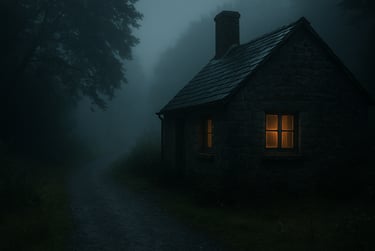Storysmith | • True Stories AND Creative Inspiration | Follow Me


FICTION
FICTION
The Cottage Murders – A Fictionalised True Crime Story
PART ONE: THE MAN WHO VANISHED
The cottage sat at the edge of the village like a forgotten punctuation mark. It had once been charming, but now it was all rotting window frames and a garden that threatened to strangle the building with nettles and ivy. People passed it in silence, maybe with a sideways glance, but no one lingered. There was something about it. Something off.
In January 1977, a man named William Holt moved in. He arrived in the middle of the night with a small suitcase, a limping gait, and a stare that didn’t quite connect with anything. The cottage had been empty for years. The village knew it. So when someone saw a dim light inside late one night, word spread fast.
William was polite, quiet, kept to himself. Said he was an illustrator working on a book. Paid rent in cash to the letting agent who’d barely remembered listing the place. No phone. No car. No visitors.
Two months later, he was gone. Vanished. The milk bottles stacked up. No one answered the door. When the landlord finally came to investigate, the place was spotless. Bed made. No food. No clothes. No sign anyone had ever lived there. Just a single strange item left in the fireplace: a child’s drawing of a red house, stick figures outside, and a man standing behind them with a knife.
It took a week before the village discovered the truth.
Buried in the garden, under a patch of disturbed earth behind the shed, were the remains of a woman and a little boy. It was clear they had been dead long before William ever moved in.
Only, no one could prove William had anything to do with it.
Because William Holt didn’t exist.
PART TWO: THE GHOST IN THE RECORDS
Police tried everything. The name William Holt matched no national records. Fingerprints were inconclusive. The drawing was sent for forensic analysis, but all they could determine was that it had been made with crayons no longer manufactured in the UK.
The woman and boy remained unidentified. No matching missing persons reports. No dental records. They were simply… off the grid.
Then one retired postman came forward. Said he remembered the woman. She'd lived in the cottage with her son briefly in 1972. Said her name was Margaret. Margaret something. Kept to herself. Didn't stay long.
Police dug into the archives. Found a name: Margaret Lonsdale. Lived in the cottage for four months before vanishing. No forwarding address. Her landlord had assumed she'd done a runner. But now it seemed she’d never left the cottage at all.
Forensics re-examined the bones. They were five years old. That meant William Holt had been living above the dead for the entire two months he was there. Either he didn’t know — or he knew all too well.
Then things got weirder.
A nearly identical drawing — a red house, stick figures, man with a knife — was found in police records. It had been discovered in a different village. In 1974. Next to a woman’s body, never identified.
The artist’s style? Identical.
Now detectives weren’t just looking for a murderer. They were looking for an artist. One who left clues in crayon.
PART THREE: THE FINAL PAGE
The break came in 1982. A woman named Claire Meadows contacted police after reading about the case in a newspaper. She was a schoolteacher in Kent and swore she recognised the drawing. One of her students — years ago — had drawn it repeatedly. He’d been placed in care after his mother vanished. The boy’s name? Robbie Holt.
Police tracked Robbie through the care system. He was now 19, working in a garage in Leeds. Shy, nervous, easily spooked. When shown the drawing, he froze.
“That’s mine,” he said. “I used to draw that house. I don’t know why. Just always saw it in my head.”
When pressed, Robbie began to recall fragments. A small house. A mother who cried a lot. A man who came at night. A shed with a broken door.It was enough.
DNA testing confirmed the woman in the garden was Margaret Lonsdale. The boy had been too traumatised to remember what happened. Social services had renamed him for protection. His original name? Robbie Lonsdale.
The man — William Holt — had abducted the boy after killing Margaret. He kept the child for weeks, moving between hostels and squats before abandoning him at a motorway service station. Robbie was found days later and placed in care, too young to tell anyone what had happened.
No trace of the man was ever found. But a handwriting analyst compared signatures on rental agreements from other unsolved cases.
There had been other cottages. Other names. Other bodies.
The man was a collector. He moved in. Stayed a while. Left his art behind.And vanished.
To this day, the killer has never been identified. But one thing is certain: in a dusty drawer in a cold case unit somewhere lies a stack of crayon drawings, each one a window into the nightmare of a boy who remembered everything — even when he didn’t know he did.
The villagers still whisper about the cottage, which has long since been demolished. But they say sometimes, just before it rains, you can smell crayons in the air.
And no one really knows why.
This story is fictionalised, but inspired by true events.



